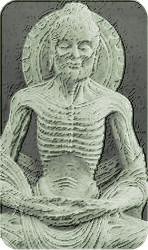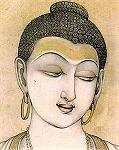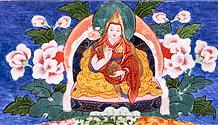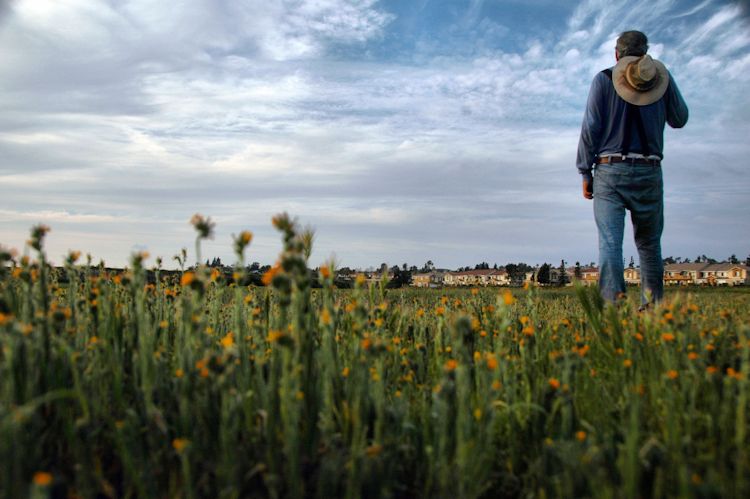Pax Nortona – A Blog by Joel Sax
From the Land of the Lost Blunderbuss
Home - Spirituality and Being - Martyrdom Series - Martyrdom 8: The Buddha
Martyrdom 8: The Buddha
Posted on May 3, 2004 in Martyrdom Series Myths & Mysticism
 It had been several days, a few weeks, since the body had begun to eat itself. The ribs showed through the thin skin of the chest. The gut sank into the basin between the bottom of the rib cage and the hips. An anatomist could have made out most of the major bones and ligaments as if the skeleton had been flayed and boiled clean.
It had been several days, a few weeks, since the body had begun to eat itself. The ribs showed through the thin skin of the chest. The gut sank into the basin between the bottom of the rib cage and the hips. An anatomist could have made out most of the major bones and ligaments as if the skeleton had been flayed and boiled clean.
He was dying. And to intensify the effect of the starvation, he sat exposed in a forest, in a place where the sun, the wind, and the rain could scratch at his body. Mosquitos and flies freely dined on his flesh and blood. For minutes at a time, he held his breath until his deprivation-weakened lungs threatened to rupture. The last silken rags of his previous life as a pampered prince barely covered his genitals.
 Why did he do this? This man, regarded as a sage by a covey of followers, felt shame for the pampered life he’d lived as a child and as a young man. He’d been born a king. Family tradition held that when he emerged from the womb, his mother died of joy at seeing the fine, smooth features of her son. His father, grieving over the loss of his wife and hearing from a wandering prophet that this boy would become so unhappy that he’d abdicate the throne and take up the life of a bhikku, a wandering mendicant, sheltered the prince in a vast pleasure dome where disease, old age, and death were unknown, unseen.
Why did he do this? This man, regarded as a sage by a covey of followers, felt shame for the pampered life he’d lived as a child and as a young man. He’d been born a king. Family tradition held that when he emerged from the womb, his mother died of joy at seeing the fine, smooth features of her son. His father, grieving over the loss of his wife and hearing from a wandering prophet that this boy would become so unhappy that he’d abdicate the throne and take up the life of a bhikku, a wandering mendicant, sheltered the prince in a vast pleasure dome where disease, old age, and death were unknown, unseen.
So the young man lived for thirty years. His father found him a wife. By this woman, he fathered children. Then the precincts of the enormous palace became too confining. He confided his claustrophobia to one of the royal charioteers who agreed to defy the ban against allowing the prince to see the outer world. They made three journeys together: on their first outing, the prince saw a man sick with a fever. The second time, an old man tottered past. And on the last occasion, a dead body lay by the side of the road.
Via his sequestering inside the palace, he’d escaped seeing these realities. Guilt for his privileged station overcame him. His wife gave birth to a son. This last joy unglued him. He saw this new being as yet another fetter of the gilded life. In the middle of the night, he slipped over the palace wall and entered the forest, seeking purpose, truth, and contrition.
Impressed by the humiliations and the tortures he wreaked on his once comfortable body that would have made a devotee of Opus Dei gasp, five companions became his disciples. Awed by his austere lifestyle, they strove to do the same.
On the day of his apparent death, he opened his eyes to the forest. Birds sang in the trees, snakes slithered through the leaves. Perhaps a butterfly flew by. These things existed in harmony with the Universe. They did not subject themselves to extremes. Though the elements battered them, they did not strive to intensify the effects. The ascetic realized that bringing himself to the edge of death had not brought him closer to the truth. Instead of cultivating a healthy poverty, he’d found a new way to indulge his coarse appetites. Resolved to restore his health, he ate again, striving not for the rich indulgences of the palace cuisine but a middle path of simple good nutrition.

His followers abandoned him, but he perservered. One night he remembered how he used to meditate beneath a rose-apple tree in his father’s garden. He recalled the lessons of the sick, the aged, and the dead, struggled beneath the stars with the mysteries of death and of life. By morning he’d achieved insight into the way things really are, yathabhuta. Four truths occurred to him, the first of which was that life consisted of suffering; the second that suffering arose from cravings and indulgences; the third that the way to reduce suffering was to live so that one’s cravings did not dominate one’s life; and the fourth that the way to reduce or eliminate those cravings was by following an Eightfold Path stressing rightness of understanding, intention, speech, action, livelihood, effort, mindfulness, and concentration.
Having realized these principles, he went to preach them to his former disciples…
The oral traditions of the Life of the Buddha were mostly not written up as the Pali Canon until some 400 to 800 years following the Buddha’s death. Early accounts suggest that while the Buddha believed in reincarnation, he did not believe in transmigration of the soul. Which means that his views resembled the laws of thermodynamics more than the New Age/Hindu fascination with past lives. Our energy is not destroyed at death, but reenters the Universe.
Other versions of the Buddha’s teachings vied for popularity. Some Mahayana accounts have Buddha born knowing his purpose as a World Savior. In an account reminiscent of popular lives of the saints, the newly born Buddha
was so lustrous and steadfast that it appeared as if the young sun had come down to earth. And yet, when people gazed at his dazzling brilliance, he held their eyes like the moon. His limbs shone with the radiant hue of precious gold, and lit up the space all around. Instantly, he walked seven steps, firmly and with long strides. In that he was like the constellation of the Seven Seers [(the Big Dipper)]. With the bearing of a lion, he surveyed the four quarters, and spoke these words full of meaning for the future: “For enlightenment I was born, for the good of all that lives. This is the last time that I have been born into this world of becoming.” [Conze, p. 36]
The prodigy Buddha feels as distant as the Docetist Christ-only-appeared-to-be-human heresy. This is special effects, not a myth to live by. Buddha becomes most appealing as a man confused by the Universe. He chooses martyrdom via the intensification of the suffering he imposes upon himself. When this nearly kills him, he comes down from his self-flagellation to live and preach a life which all men and women can attain. The first sanghas or Buddhist communities ignore caste: people of any profession may achieve enlightenment by following the Eightfold Path. It is a democratic religion. The Buddha is human.

Buddhists living in the West react warily when comparisons are drawn between them and Christianity. Recently, I likened the practice of chanting to the recitation of the Rosary to a member of the Pure Land Sect. The analogy discomforted her. I think this is because of the nature of past encounters between Buddhism and Christianity. Where Buddhists speak of peace if you follow their path, Christians talk of damnation if you don’t follow their’s. When you attempt to draw parallels between the two faiths, Christians are quick to declare their’s superior. Christ suffered on the cross, they will often say. The Buddha did no such thing.
This “moronic….oxymoronic” beating of the cross over the heads of nonbelievers — as Mute Troubadour recently characterized this certain style of prostelytization on his tagboard — alienates many targets. Attracting people by martyring them strikes the Buddhist as no better than the attempts by the Buddha to torture himself in the forest: you don’t promote enlightenment by this means. You merely increase the level of suffering in another person’s life until she gives in.
Yet there are instances of martyrdom among Buddhists, such as these Vietnamese monks who immolated themselves in protest against the Catholic Saigon regime’s persecutions. In a religion which preaches care of the body, it’s difficult to justify these suicides.
The theme of self-sacrifice is not entirely unknown, however. In one Jataka or animal tale, the Buddha incarnates as a golden deer. When a pregnant doe begs him to allow her to postpone her turn at the slaughter:
Nigrodha [the Deer King] himself went to the execution block and showed his readiness for the slaughter. Surprised at the presence of the golden deer eagerly awaiting its slaughter despite the immunity granted, the king’s men reported the matter to the king.
The king was also surprised. He immediately arrived at the park and asked the deer king to explain the cause for his willingness to be killed. Nigrodha then said, “Sir! A pregnant doe came to me and prayed to let her turn fall on the other. So, to save the life of two deer, I decide to get killed.”
The King spares the Deer King and all his subjects ever afterwards.
That image of the burning monks nevertheless still haunts closed Western eyes. In them, I think, we see what we have rejected in Christianity: the idea of giving one’s own life in sacrifice. I do not condone the petty martyrdoms of groups such as Opus Dei. Nevertheless, I feel that our fear of suffering has turned we Westerners into monsters. We develop missiles so that we won’t look those we kill in the eye. We plunder nations so that we may live in palaces. We allow despots to seize our governments and when they curb our freedoms to “protect us from terror”, we accede to their wishes.
Judeo-Christian America lives from gore-fest to gore-fest. We decry violence and at the same time, rush to the television set to watch the World Trade Center fall another time and another time. We flock to watch Christ turned into a bloodied steak, a commercial for fascism. All this horror serves to prop up our addiction to indulgences. We believe that our microwaves, our SUVs, our computers, our televisions, and our vacation resorts will deliver us from pain.
Which leads me to ask whether Christianity as expressed in America today speaks to our condition. Christ preached in a land under occupation. We are the occupiers of Iraq, Puerto Rico, and various patches of paved over field that we have obtained by treaty throughout the world. The message of Christ sought to help people who were thralls to military force. With our taxes and our votes, we promote such force. I have come to believe that the reason we miss the impact of Christ’s teachings is that we are no longer like the people of Roman-occupied Israel.
We are the Romans.
If Christianity is to reform America, we must, I think, reconsider the ways in which it was influenced by Buddhism. It has taken more than 2500 years for the Buddha’s message to start to take hold in the West. There are parallels between Christ and the Buddha, strong parallels. The differences, I think, come from the fact that Christ came from the oppressed and Buddha came from the oppressors.
Christ speaks of the difficulty for rich men to enter Heaven. The Buddha believed that excessive wealth and excessive poverty were both bad. One strove for a Middle Path of health in the body and compassion. Rather than world renouncing, the disciplines of Buddhism bring us into profound contact with the world. If in recent centuries, Buddhists haven’t waged expansive wars, it is perhaps because they don’t attempt to build painless New Jerusalem’s on the earth. The warts and the wounds and the ulcers and the cancers are unavoidable, the Buddha teaches. No matter what you invent, you will still experience suffering. This first Noble Truth teaches the followers of the Buddha not to go to extremes. The world — that bitter illusion — impinges on our bodies every moment we live. The secret isn’t ending it or revelling in it, it is to learn to live with it.
Americans may be so drenched in the antinomian belief that Christ’s blood exonerates them from all evil that what is needed is a sea change, a conversion to something else. Whether this will happen within Christianity or by conversion to Buddhism or through acceptance of a new prophet remains to be seen. The message that we cannot escape suffering must come central to that new movement. It is essential that we change before the Illusion of Painless Living smites us in the face and drives us bezerk.
Perhaps that already happened on 9-11. The trouble is that we got the wrong message and did not divorce ourselves from a belief that what cannot be can be.


